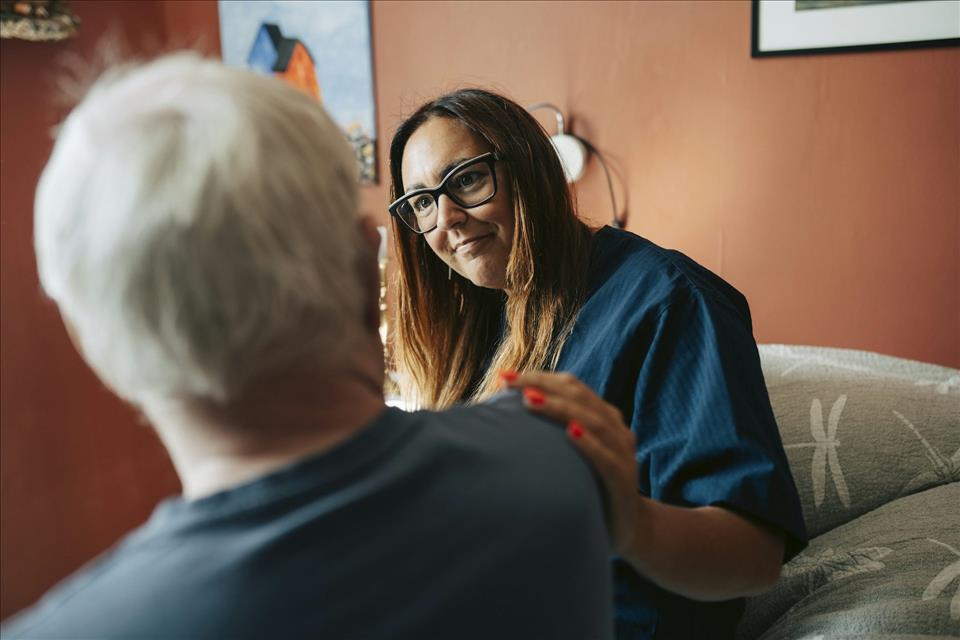
For Many People With Acute Mental Illness, 'Hospital In The Home' Means Living Well In The Community
The ABC reports voluntary patients at Kempsey District Hospital will either be transferred to a new“hospital in the home” program or a neighbouring hospital, while involuntary patients will be transferred to Port Macquarie Base Hospital, 55 kilometres away.
The NSW government says if the hospital in the home program is successful, it could be rolled out across the state.
While some locals have raised concerns about the risks of care at home, the move is the next step in a long process of establishing good mental health care in the community.
Governments committed to de-institutionalisation about 40 years ago, promising a range of services to support people with mental illness to live well and get the treatment they need in the community.
However, this shift has been slow going.
Mental health system under financial pressureOur mental health system is under enormous pressure. The amount of funding mental health receives as a share of total health spending, about 7%, hasn't changed since 1992.
But the burden of disease attributable to mental health and addictions has. It now accounts for around 15% of the total disease burden.
Australia's response to mental illness has become hospital-centric. Hospital-based expenditure accounts for the largest component of state and territory spending on mental health, close to 80%. This type of care is also the most expensive, leaving only a fraction to spend on mental health care in other settings.
Australia was a pioneer in hospital alternativesAustralia has pioneered alternatives to hospitalisation for mental illness. As early as 1907, community organisations such as the Aftercare Association were working to find patients housing, care and work in the community, outside the asylums.
By the 1970s and '80s, spurred by key inquiries such as the Richmond Report, Australia's response to mental illness shifted to providing care through a network of services focused on treating and supporting people in the community.
As part of this mix, the hospital in the home model emerged, offering patients more options and helping to manage hospital bed demand. It's now an established model of mental health care across Australia.
So what is hospital in the home for mental health?Hospital in the home provides acute, hospital-level mental health care for patients in their own home, rather than having to be admitted to hospital.
It offers a comparable level of care in a familiar environment. The hospital in the home team, which can include psychiatrists, psychologists, nurses, allied health and peer workers, develops a treatment plan and provides care at home. This may involve daily home visits or, in some cases, appointments at a clinic or online.
The team works with the patient to create a treatment and recovery plan, often involving family and carers with the patient's permission.
Discharge planning begins at the start of admission, with the goal of getting the patient back to their usual level of functioning in the community as soon as possible.
What does the evidence say?Hospital in the home is backed by good evidence which shows it's an effective alternative to hospital-based care and can shorten length of stay and reduce the need for subsequent admissions.
Compared with hospital-based care, hospital in the home also has a reduced risk of adverse events such as seclusion and restraint.
Many people find it more comfortable and would prefer hospital in the home to hospital admission. As one person pointed out, hospital in the home care:
There are also clients for whom this kind of service may not be appropriate, including those at very high risk of suicide.
Expanding options for care in the communityNew Zealand spends more than 20% of its mental health funding on community-based services, compared with Australia's 7%. NZ offers consumers many more alternatives to hospital care.
One such service is Tupu Ake, a consumer-run acute public psychiatric“ward”, supported by clinical and professional staff, but in a lovely house in south Auckland. Tupu Ake has reduced the need for acute hospital admission.
Successive mental health reports and inquiries in Australia have long recommended the establishment of a vibrant community mental health sector, including hospital in the home.
But this choice remains rare. Access to programs – including Orygen @ Home, which provides acute mental health care for young people in their home – is sought-after but very limited.
Home-based programs need adequate fundingThe unsustainable acute pressure facing hospitals is now driving health services to urgently consider alternative models of care.
St Vincent's Health Australia, for example, this week announced it would shift half of its services to home-based or online care over the next five years. Hospitals would be dedicated to emergency wards and intensive care.
This comes as federal and state/territory governments negotiate the next five-year next national health and hospital funding agreement.
Alternatives such as hospital in the home should feature prominently in the new funding agreement, as part of an overall strategy to reduce the hospital-centric nature of our mental health system.
But in doing so, it will be important to stay faithful to both the philosophy and the model of care that underpins hospital in the home for mental health. Replacing suboptimal hospital-based care with suboptimal home-based care is unacceptable.

Legal Disclaimer:
MENAFN provides the
information “as is” without warranty of any kind. We do not accept
any responsibility or liability for the accuracy, content, images,
videos, licenses, completeness, legality, or reliability of the information
contained in this article. If you have any complaints or copyright
issues related to this article, kindly contact the provider above.


















Comments
No comment